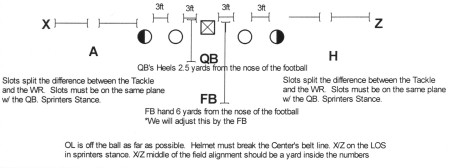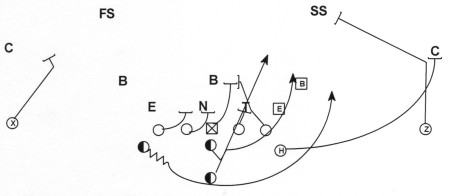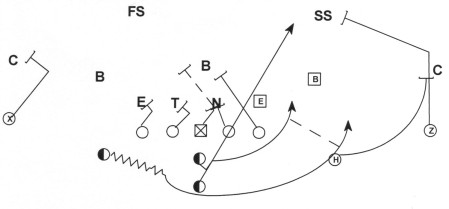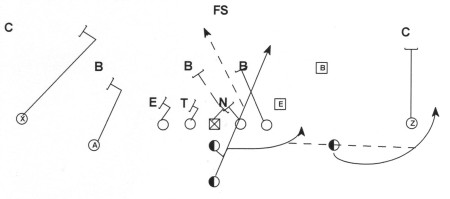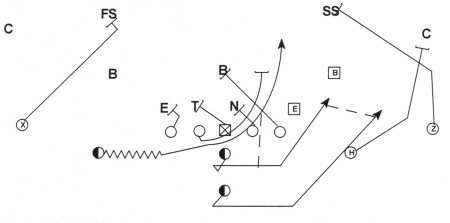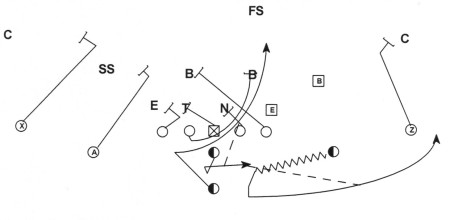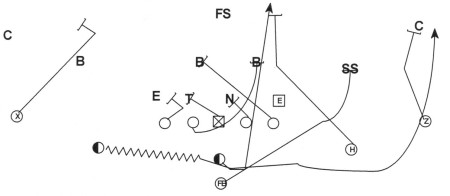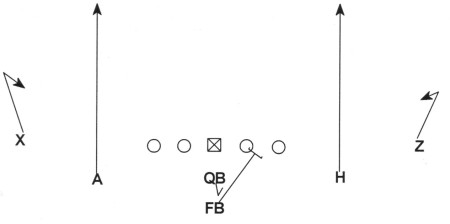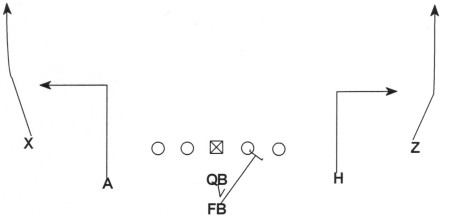Article CategoriesAFM Magazine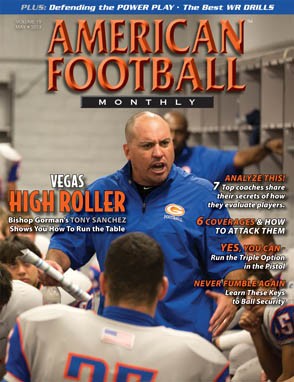
|
Running the Triple Option in the Pistolby: Nate CochranOffensive Coordinator, Alma College © More from this issue Using the triple option with the pistol offense is a natural fit and can improve both your running and passing game. Like Army and Navy, we have been a traditional triple option team and have experienced success because our offense gave us a way to compete against superior talent. While we have had a potent rushing attack, when teams put nine or ten players in the box we didn’t have an answer. Last season, we decided to experiment and add the pistol to our offense. Adding the pistol to our offense gave us a way to make defenses more accountable for protecting the field vertically as well as horizontally. The pistol expanded our triple option and our quick passing game options that allowed us to move the ball more successfully. We set our quarterback’s heels at two and a half yards from the nose of the football. Our slots align four yards from the tackles and even with the quarterback. The depth of the slots helps us hide the action of the motion from the defense. Our fullback is in a three- point stance and sets his heels six and a half yards from the nose of the football (Diagram 1). We do not use a traditional fullback. We don’t want a “bruiser,” but a tailback-type who wasn’t afraid to run inside. The slots and fullback are interchangeable athletes.
Diagram 1. The pistol gives our offense four different triple options without having to change the reads for our quarterback. Our quarterback had always run the triple option, so we try to make the reads as easy for him as possible. In Diagram 2, you can see how we ran the traditional triple option from our normal spread formation without the pistol. In Diagram 3, you see there is very little difference while we are in the pistol. The pistol snap does take considerable practice. Our backside tackle and guard do not scoop as performed in the traditional triple option. We use a “wall off” technique which allows our fullback to cut back and, therefore, we don’t get run down by the backside defensive end. Also, being in the pistol places our quarterback farther away from the dive read which makes it easier to read. The pistol also moves the pitch read further away from the quarterback, giving us less chances of facing bullet reads (e.g., the dive read crashing on the fullback and the pitch read coming at the same time) off the edge.
Diagram 2.
Diagram 3. From the pistol, we are able to run other versions of the triple option that utilize the same reads and give the defenses different looks. We use a dive/bubble concept. This keeps defenses from keying the pitch motion and trying to run the safety in our alleys (Diagram 4). Our QB places his feet in the same location as in the triple option and reads the same defenders. When the quarterback comes off the mesh, he runs to the sideline, unlike our normal triple option. This makes it easier for him to throw the bubble. If the “pitch read” goes with the bubble, the quarterback turns upfield and attacks the alley. Diagram 5 and Diagram 6 are two shovel concepts we use. The shovel pass is always a safe play because if the shovel back drops the pitch, it’s an incomplete pass. The reads are the same for the quarterback. We teach him to catch the snap and back up two steps. He must set his feet and read the normal dive read. If the dive read takes the shovel back, the quarterback can take off and attack the pitch read. In Diagram 6, we want the QB to attack the sideline so he can throw the bubble.
Diagram 4.
Diagram 5.
Diagram 6. One variant the pistol provides us is a jet sweep play. This is the type of play you see many spread teams run. This play is an example of an “outside midline.” As shown in Diagram 7, we back our quarterback up to three and a half yards to put more distance between the read and our sweeping slot. We also tell the slot to bubble away from the line of scrimmage somewhat after the handoff. The difficulty with this play is it works the opposite of what we teach our quarterback on most read plays. In this play, if the read closes down on the tackle, we want the quarterback to give the football to the slot coming in motion. If the read comes upfield or widens with the sweep, we want the quarterback to keep the football. Our quarterback will step back off the ball and take shuffle steps with the slot as he runs the sweep, all while keeping his eyes on the read. This play is a great complement to our triple option.
Diagram 7. The pistol also helps our offense achieve a more effective passing game. We utilize a quick passing game along with our play-action passes. We use three quick passing concepts that are very effective for us. In Diagrams 8, 9, and 10, you can see our different concepts. We teach our quarterback to read “softest coverage” and “shortest throw.” In Diagram 8, we tell the quarterback to read his normal pitch read. If the read goes immediately to the bubble, the quarterback should throw the slant. If the pitch read is backed up, the quarterback is taught to throw the bubble. In Diagram 9, we use a hitch-seam concept and, in Diagram 10, we use a flat-fade concept. The selections are high percentage throws for our quarterback and we use these to build his throwing confidence.
Diagram 8.
Diagram 9.
Diagram 10. Using the pistol to complement your spread triple option offense is a natural fit. It requires a very structured practice time to implement the pistol snap. Quarterbacks and centers must work on the snap every day. We have a specific practice time called the “Ride n’ Decide” period and we incorporate the pistol snap into it. The pistol is a desirable complement to the triple option because it still allows you to have a natural “downhill” running game. It can also help an option quarterback who is not used to dropping back to pass. Coach Cochran answers your questions on Facebook - just go Want more like this? Multiplicity – Using Personnel Groupings to Enhance Your Offense and Player Morale – May, 2012 |
|
| HOME |
MAGAZINE |
SUBSCRIBE | ONLINE COLUMNISTS | COACHING VIDEOS |
Copyright 2024, AmericanFootballMonthly.com
All Rights Reserved


